The Role of Leadership and Management in ASDA Operations Management
VerifiedAdded on 2023/01/16
|11
|3397
|99
Report
AI Summary
This report provides an overview of operations management, focusing on the roles of leadership and management within the context of ASDA. It examines various leadership theories, including situational, systems, and contingency leadership, and their application in achieving organizational goals. The report also discusses different approaches to operational management, such as Just-in-Time (JIT), Total Quality Management (TQM), and Lean Manufacturing, highlighting the importance of each in optimizing productivity, quality, and customer satisfaction. Furthermore, it emphasizes the significance of operations management in achieving business objectives and explores the impact of environmental factors on operational decision-making within ASDA. The analysis covers how managers and leaders can leverage these approaches to improve efficiency, reduce waste, and enhance overall business performance.
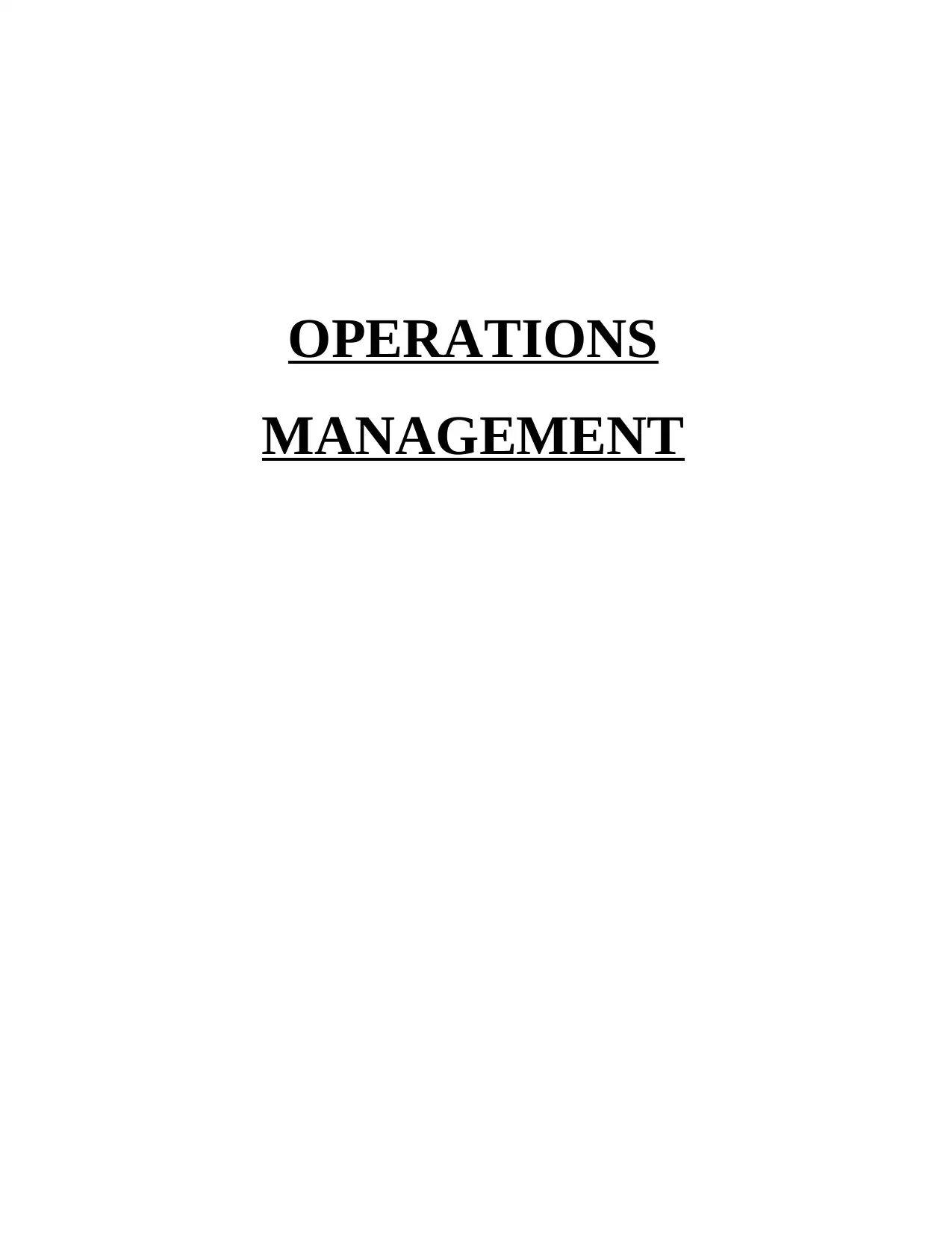
OPERATIONS
MANAGEMENT
MANAGEMENT
Paraphrase This Document
Need a fresh take? Get an instant paraphrase of this document with our AI Paraphraser
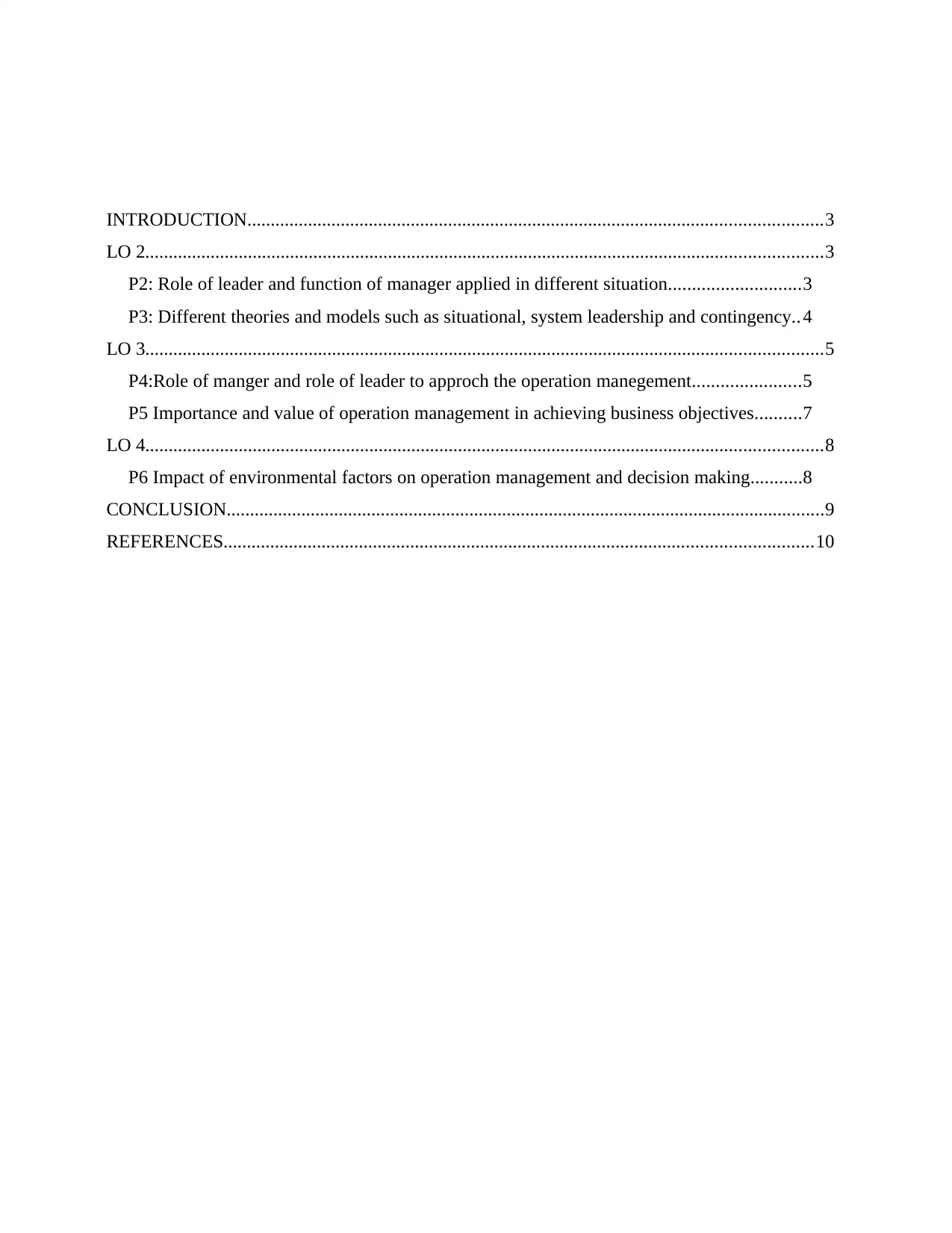
INTRODUCTION...........................................................................................................................3
LO 2.................................................................................................................................................3
P2: Role of leader and function of manager applied in different situation............................3
P3: Different theories and models such as situational, system leadership and contingency..4
LO 3.................................................................................................................................................5
P4:Role of manger and role of leader to approch the operation manegement.......................5
P5 Importance and value of operation management in achieving business objectives..........7
LO 4.................................................................................................................................................8
P6 Impact of environmental factors on operation management and decision making...........8
CONCLUSION................................................................................................................................9
REFERENCES..............................................................................................................................10
LO 2.................................................................................................................................................3
P2: Role of leader and function of manager applied in different situation............................3
P3: Different theories and models such as situational, system leadership and contingency..4
LO 3.................................................................................................................................................5
P4:Role of manger and role of leader to approch the operation manegement.......................5
P5 Importance and value of operation management in achieving business objectives..........7
LO 4.................................................................................................................................................8
P6 Impact of environmental factors on operation management and decision making...........8
CONCLUSION................................................................................................................................9
REFERENCES..............................................................................................................................10
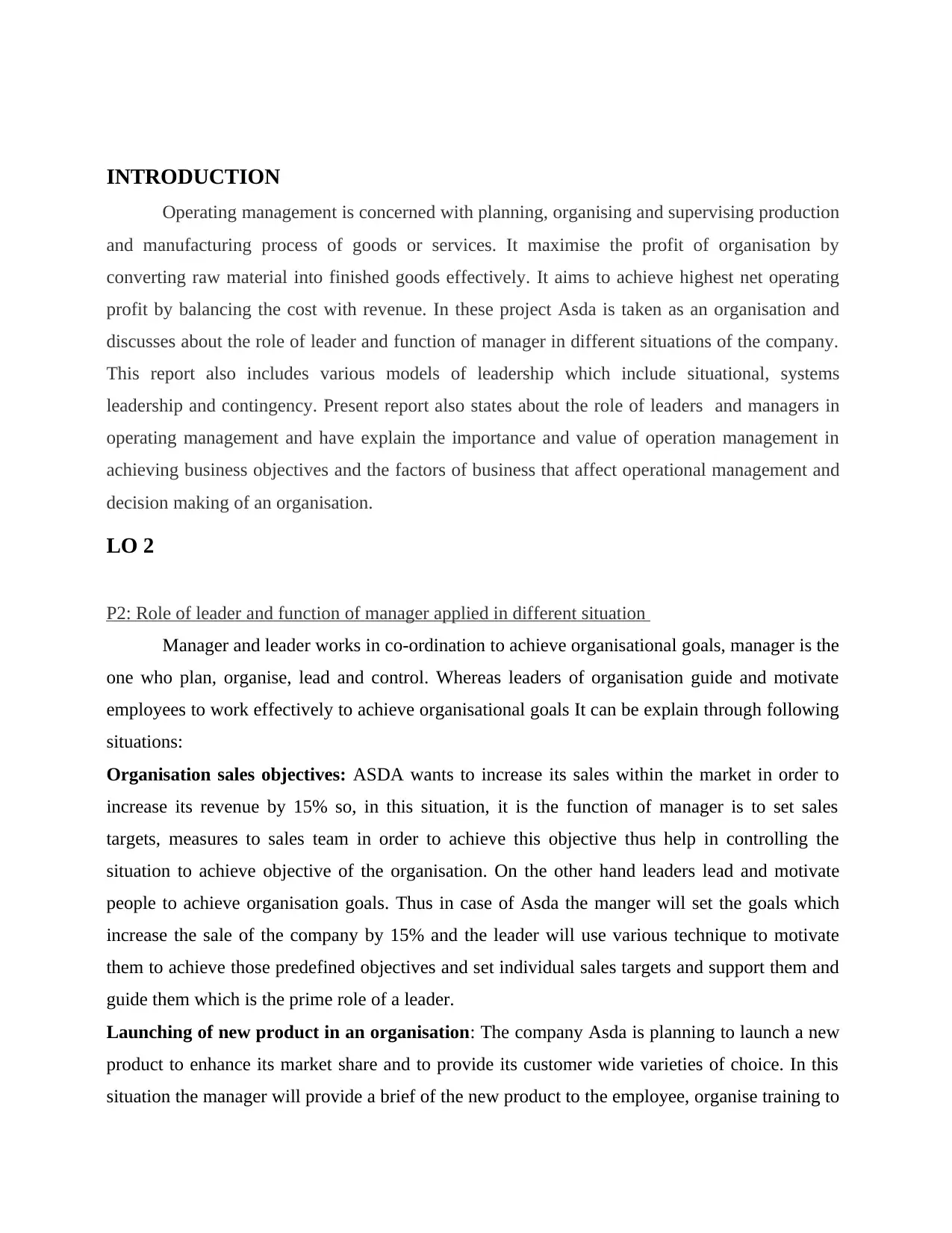
INTRODUCTION
Operating management is concerned with planning, organising and supervising production
and manufacturing process of goods or services. It maximise the profit of organisation by
converting raw material into finished goods effectively. It aims to achieve highest net operating
profit by balancing the cost with revenue. In these project Asda is taken as an organisation and
discusses about the role of leader and function of manager in different situations of the company.
This report also includes various models of leadership which include situational, systems
leadership and contingency. Present report also states about the role of leaders and managers in
operating management and have explain the importance and value of operation management in
achieving business objectives and the factors of business that affect operational management and
decision making of an organisation.
LO 2
P2: Role of leader and function of manager applied in different situation
Manager and leader works in co-ordination to achieve organisational goals, manager is the
one who plan, organise, lead and control. Whereas leaders of organisation guide and motivate
employees to work effectively to achieve organisational goals It can be explain through following
situations:
Organisation sales objectives: ASDA wants to increase its sales within the market in order to
increase its revenue by 15% so, in this situation, it is the function of manager is to set sales
targets, measures to sales team in order to achieve this objective thus help in controlling the
situation to achieve objective of the organisation. On the other hand leaders lead and motivate
people to achieve organisation goals. Thus in case of Asda the manger will set the goals which
increase the sale of the company by 15% and the leader will use various technique to motivate
them to achieve those predefined objectives and set individual sales targets and support them and
guide them which is the prime role of a leader.
Launching of new product in an organisation: The company Asda is planning to launch a new
product to enhance its market share and to provide its customer wide varieties of choice. In this
situation the manager will provide a brief of the new product to the employee, organise training to
Operating management is concerned with planning, organising and supervising production
and manufacturing process of goods or services. It maximise the profit of organisation by
converting raw material into finished goods effectively. It aims to achieve highest net operating
profit by balancing the cost with revenue. In these project Asda is taken as an organisation and
discusses about the role of leader and function of manager in different situations of the company.
This report also includes various models of leadership which include situational, systems
leadership and contingency. Present report also states about the role of leaders and managers in
operating management and have explain the importance and value of operation management in
achieving business objectives and the factors of business that affect operational management and
decision making of an organisation.
LO 2
P2: Role of leader and function of manager applied in different situation
Manager and leader works in co-ordination to achieve organisational goals, manager is the
one who plan, organise, lead and control. Whereas leaders of organisation guide and motivate
employees to work effectively to achieve organisational goals It can be explain through following
situations:
Organisation sales objectives: ASDA wants to increase its sales within the market in order to
increase its revenue by 15% so, in this situation, it is the function of manager is to set sales
targets, measures to sales team in order to achieve this objective thus help in controlling the
situation to achieve objective of the organisation. On the other hand leaders lead and motivate
people to achieve organisation goals. Thus in case of Asda the manger will set the goals which
increase the sale of the company by 15% and the leader will use various technique to motivate
them to achieve those predefined objectives and set individual sales targets and support them and
guide them which is the prime role of a leader.
Launching of new product in an organisation: The company Asda is planning to launch a new
product to enhance its market share and to provide its customer wide varieties of choice. In this
situation the manager will provide a brief of the new product to the employee, organise training to
⊘ This is a preview!⊘
Do you want full access?
Subscribe today to unlock all pages.

Trusted by 1+ million students worldwide
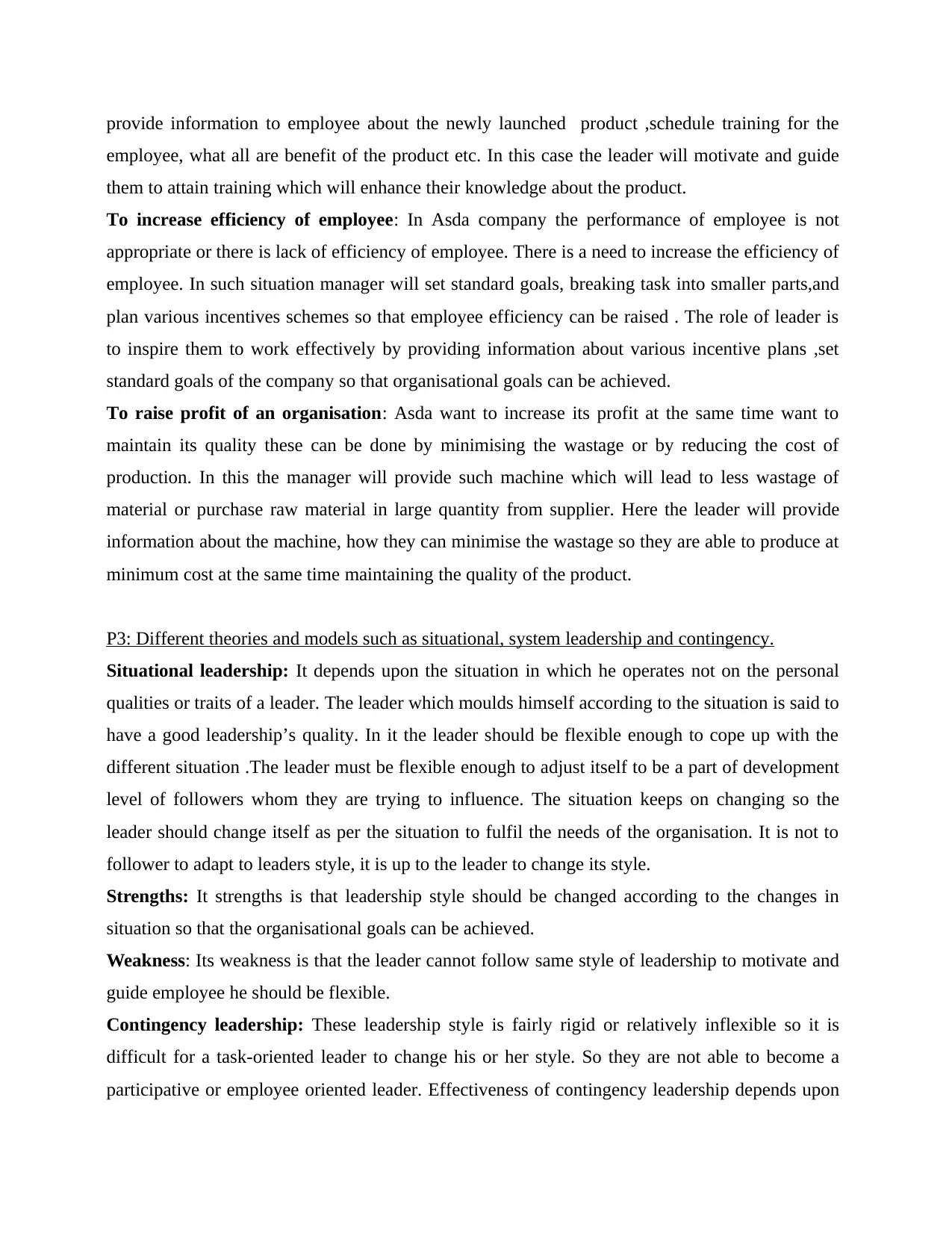
provide information to employee about the newly launched product ,schedule training for the
employee, what all are benefit of the product etc. In this case the leader will motivate and guide
them to attain training which will enhance their knowledge about the product.
To increase efficiency of employee: In Asda company the performance of employee is not
appropriate or there is lack of efficiency of employee. There is a need to increase the efficiency of
employee. In such situation manager will set standard goals, breaking task into smaller parts,and
plan various incentives schemes so that employee efficiency can be raised . The role of leader is
to inspire them to work effectively by providing information about various incentive plans ,set
standard goals of the company so that organisational goals can be achieved.
To raise profit of an organisation: Asda want to increase its profit at the same time want to
maintain its quality these can be done by minimising the wastage or by reducing the cost of
production. In this the manager will provide such machine which will lead to less wastage of
material or purchase raw material in large quantity from supplier. Here the leader will provide
information about the machine, how they can minimise the wastage so they are able to produce at
minimum cost at the same time maintaining the quality of the product.
P3: Different theories and models such as situational, system leadership and contingency.
Situational leadership: It depends upon the situation in which he operates not on the personal
qualities or traits of a leader. The leader which moulds himself according to the situation is said to
have a good leadership’s quality. In it the leader should be flexible enough to cope up with the
different situation .The leader must be flexible enough to adjust itself to be a part of development
level of followers whom they are trying to influence. The situation keeps on changing so the
leader should change itself as per the situation to fulfil the needs of the organisation. It is not to
follower to adapt to leaders style, it is up to the leader to change its style.
Strengths: It strengths is that leadership style should be changed according to the changes in
situation so that the organisational goals can be achieved.
Weakness: Its weakness is that the leader cannot follow same style of leadership to motivate and
guide employee he should be flexible.
Contingency leadership: These leadership style is fairly rigid or relatively inflexible so it is
difficult for a task-oriented leader to change his or her style. So they are not able to become a
participative or employee oriented leader. Effectiveness of contingency leadership depends upon
employee, what all are benefit of the product etc. In this case the leader will motivate and guide
them to attain training which will enhance their knowledge about the product.
To increase efficiency of employee: In Asda company the performance of employee is not
appropriate or there is lack of efficiency of employee. There is a need to increase the efficiency of
employee. In such situation manager will set standard goals, breaking task into smaller parts,and
plan various incentives schemes so that employee efficiency can be raised . The role of leader is
to inspire them to work effectively by providing information about various incentive plans ,set
standard goals of the company so that organisational goals can be achieved.
To raise profit of an organisation: Asda want to increase its profit at the same time want to
maintain its quality these can be done by minimising the wastage or by reducing the cost of
production. In this the manager will provide such machine which will lead to less wastage of
material or purchase raw material in large quantity from supplier. Here the leader will provide
information about the machine, how they can minimise the wastage so they are able to produce at
minimum cost at the same time maintaining the quality of the product.
P3: Different theories and models such as situational, system leadership and contingency.
Situational leadership: It depends upon the situation in which he operates not on the personal
qualities or traits of a leader. The leader which moulds himself according to the situation is said to
have a good leadership’s quality. In it the leader should be flexible enough to cope up with the
different situation .The leader must be flexible enough to adjust itself to be a part of development
level of followers whom they are trying to influence. The situation keeps on changing so the
leader should change itself as per the situation to fulfil the needs of the organisation. It is not to
follower to adapt to leaders style, it is up to the leader to change its style.
Strengths: It strengths is that leadership style should be changed according to the changes in
situation so that the organisational goals can be achieved.
Weakness: Its weakness is that the leader cannot follow same style of leadership to motivate and
guide employee he should be flexible.
Contingency leadership: These leadership style is fairly rigid or relatively inflexible so it is
difficult for a task-oriented leader to change his or her style. So they are not able to become a
participative or employee oriented leader. Effectiveness of contingency leadership depends upon
Paraphrase This Document
Need a fresh take? Get an instant paraphrase of this document with our AI Paraphraser
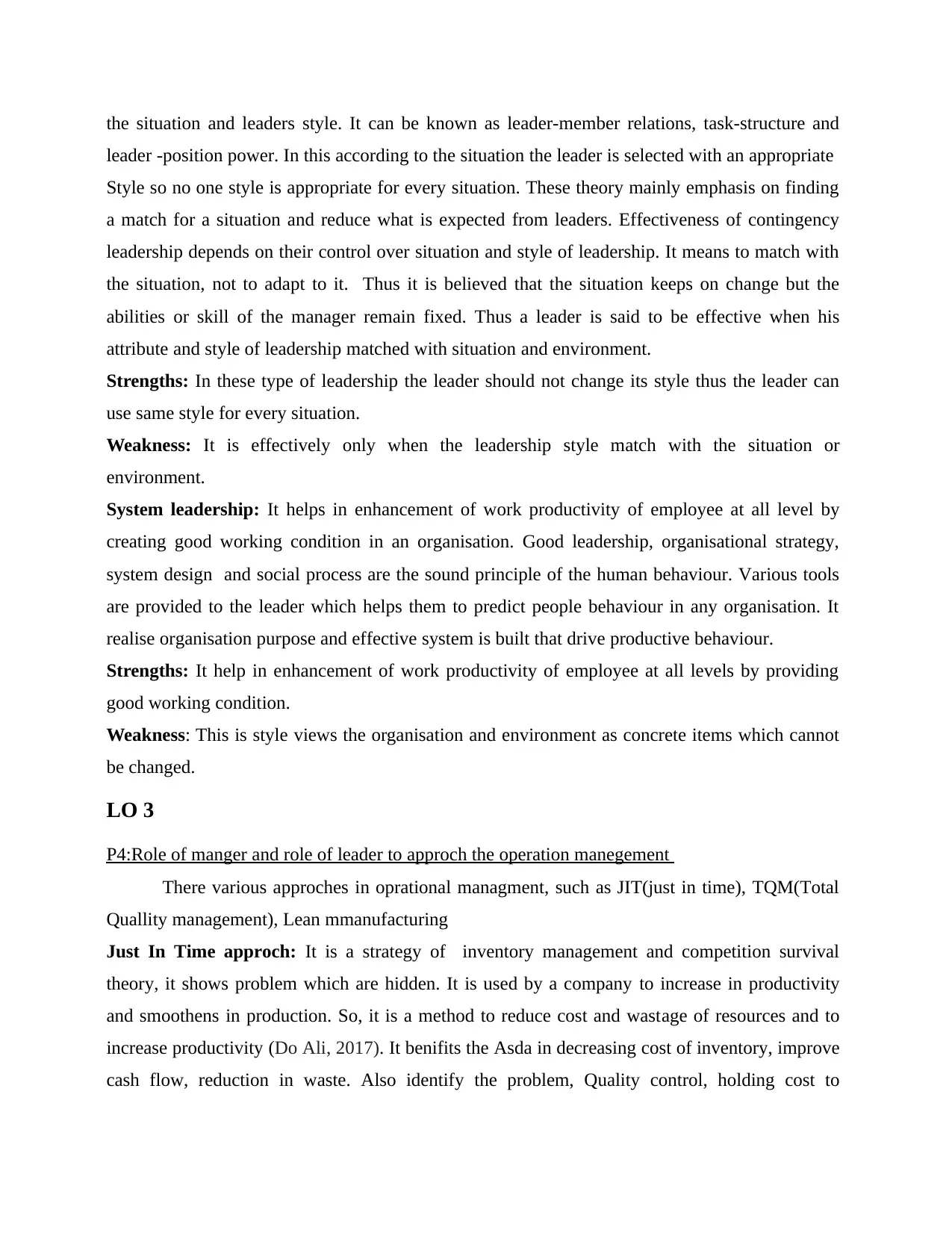
the situation and leaders style. It can be known as leader-member relations, task-structure and
leader -position power. In this according to the situation the leader is selected with an appropriate
Style so no one style is appropriate for every situation. These theory mainly emphasis on finding
a match for a situation and reduce what is expected from leaders. Effectiveness of contingency
leadership depends on their control over situation and style of leadership. It means to match with
the situation, not to adapt to it. Thus it is believed that the situation keeps on change but the
abilities or skill of the manager remain fixed. Thus a leader is said to be effective when his
attribute and style of leadership matched with situation and environment.
Strengths: In these type of leadership the leader should not change its style thus the leader can
use same style for every situation.
Weakness: It is effectively only when the leadership style match with the situation or
environment.
System leadership: It helps in enhancement of work productivity of employee at all level by
creating good working condition in an organisation. Good leadership, organisational strategy,
system design and social process are the sound principle of the human behaviour. Various tools
are provided to the leader which helps them to predict people behaviour in any organisation. It
realise organisation purpose and effective system is built that drive productive behaviour.
Strengths: It help in enhancement of work productivity of employee at all levels by providing
good working condition.
Weakness: This is style views the organisation and environment as concrete items which cannot
be changed.
LO 3
P4:Role of manger and role of leader to approch the operation manegement
There various approches in oprational managment, such as JIT(just in time), TQM(Total
Quallity management), Lean mmanufacturing
Just In Time approch: It is a strategy of inventory management and competition survival
theory, it shows problem which are hidden. It is used by a company to increase in productivity
and smoothens in production. So, it is a method to reduce cost and wastage of resources and to
increase productivity (Do Ali, 2017). It benifits the Asda in decreasing cost of inventory, improve
cash flow, reduction in waste. Also identify the problem, Quality control, holding cost to
leader -position power. In this according to the situation the leader is selected with an appropriate
Style so no one style is appropriate for every situation. These theory mainly emphasis on finding
a match for a situation and reduce what is expected from leaders. Effectiveness of contingency
leadership depends on their control over situation and style of leadership. It means to match with
the situation, not to adapt to it. Thus it is believed that the situation keeps on change but the
abilities or skill of the manager remain fixed. Thus a leader is said to be effective when his
attribute and style of leadership matched with situation and environment.
Strengths: In these type of leadership the leader should not change its style thus the leader can
use same style for every situation.
Weakness: It is effectively only when the leadership style match with the situation or
environment.
System leadership: It helps in enhancement of work productivity of employee at all level by
creating good working condition in an organisation. Good leadership, organisational strategy,
system design and social process are the sound principle of the human behaviour. Various tools
are provided to the leader which helps them to predict people behaviour in any organisation. It
realise organisation purpose and effective system is built that drive productive behaviour.
Strengths: It help in enhancement of work productivity of employee at all levels by providing
good working condition.
Weakness: This is style views the organisation and environment as concrete items which cannot
be changed.
LO 3
P4:Role of manger and role of leader to approch the operation manegement
There various approches in oprational managment, such as JIT(just in time), TQM(Total
Quallity management), Lean mmanufacturing
Just In Time approch: It is a strategy of inventory management and competition survival
theory, it shows problem which are hidden. It is used by a company to increase in productivity
and smoothens in production. So, it is a method to reduce cost and wastage of resources and to
increase productivity (Do Ali, 2017). It benifits the Asda in decreasing cost of inventory, improve
cash flow, reduction in waste. Also identify the problem, Quality control, holding cost to
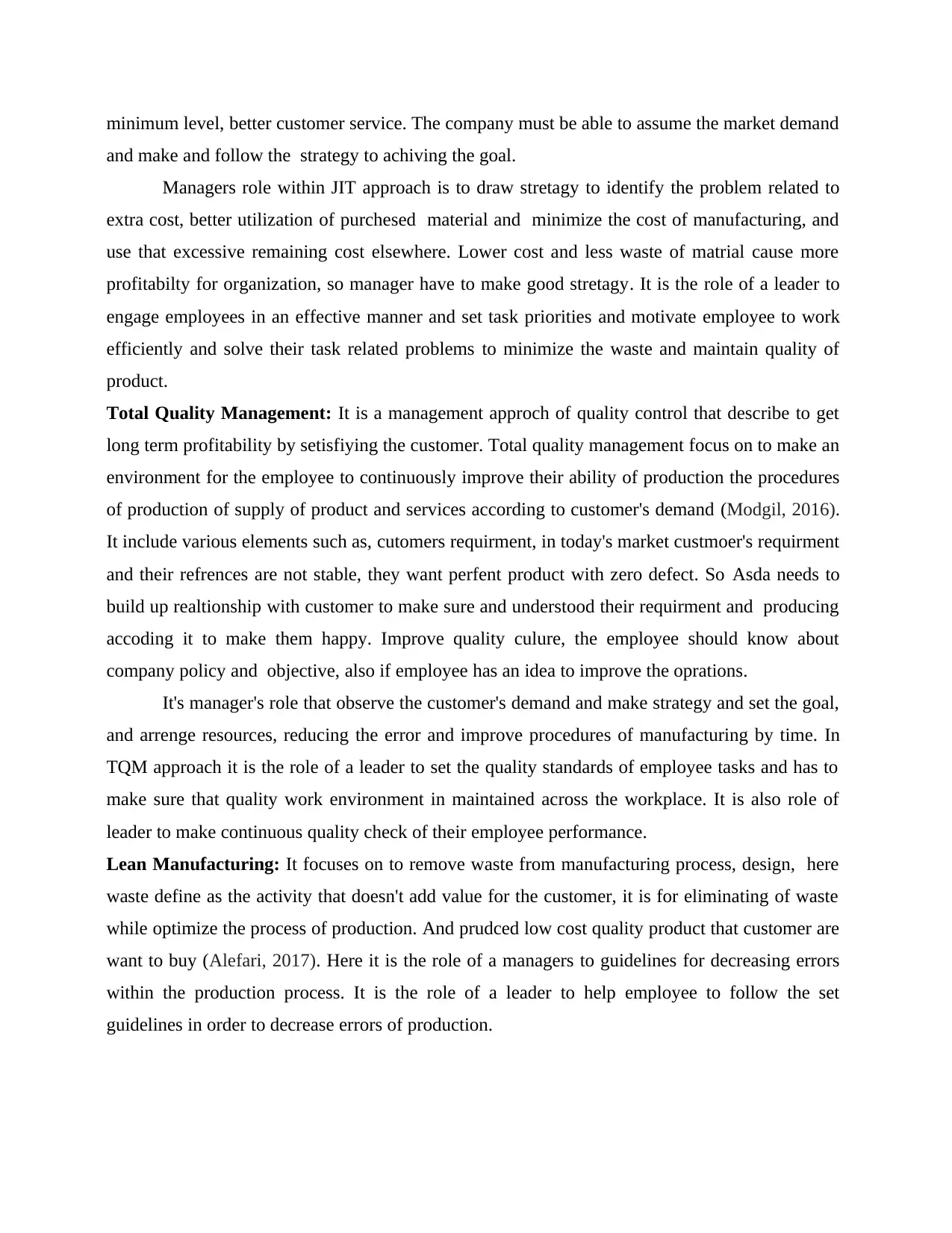
minimum level, better customer service. The company must be able to assume the market demand
and make and follow the strategy to achiving the goal.
Managers role within JIT approach is to draw stretagy to identify the problem related to
extra cost, better utilization of purchesed material and minimize the cost of manufacturing, and
use that excessive remaining cost elsewhere. Lower cost and less waste of matrial cause more
profitabilty for organization, so manager have to make good stretagy. It is the role of a leader to
engage employees in an effective manner and set task priorities and motivate employee to work
efficiently and solve their task related problems to minimize the waste and maintain quality of
product.
Total Quality Management: It is a management approch of quality control that describe to get
long term profitability by setisfiying the customer. Total quality management focus on to make an
environment for the employee to continuously improve their ability of production the procedures
of production of supply of product and services according to customer's demand (Modgil, 2016).
It include various elements such as, cutomers requirment, in today's market custmoer's requirment
and their refrences are not stable, they want perfent product with zero defect. So Asda needs to
build up realtionship with customer to make sure and understood their requirment and producing
accoding it to make them happy. Improve quality culure, the employee should know about
company policy and objective, also if employee has an idea to improve the oprations.
It's manager's role that observe the customer's demand and make strategy and set the goal,
and arrenge resources, reducing the error and improve procedures of manufacturing by time. In
TQM approach it is the role of a leader to set the quality standards of employee tasks and has to
make sure that quality work environment in maintained across the workplace. It is also role of
leader to make continuous quality check of their employee performance.
Lean Manufacturing: It focuses on to remove waste from manufacturing process, design, here
waste define as the activity that doesn't add value for the customer, it is for eliminating of waste
while optimize the process of production. And prudced low cost quality product that customer are
want to buy (Alefari, 2017). Here it is the role of a managers to guidelines for decreasing errors
within the production process. It is the role of a leader to help employee to follow the set
guidelines in order to decrease errors of production.
and make and follow the strategy to achiving the goal.
Managers role within JIT approach is to draw stretagy to identify the problem related to
extra cost, better utilization of purchesed material and minimize the cost of manufacturing, and
use that excessive remaining cost elsewhere. Lower cost and less waste of matrial cause more
profitabilty for organization, so manager have to make good stretagy. It is the role of a leader to
engage employees in an effective manner and set task priorities and motivate employee to work
efficiently and solve their task related problems to minimize the waste and maintain quality of
product.
Total Quality Management: It is a management approch of quality control that describe to get
long term profitability by setisfiying the customer. Total quality management focus on to make an
environment for the employee to continuously improve their ability of production the procedures
of production of supply of product and services according to customer's demand (Modgil, 2016).
It include various elements such as, cutomers requirment, in today's market custmoer's requirment
and their refrences are not stable, they want perfent product with zero defect. So Asda needs to
build up realtionship with customer to make sure and understood their requirment and producing
accoding it to make them happy. Improve quality culure, the employee should know about
company policy and objective, also if employee has an idea to improve the oprations.
It's manager's role that observe the customer's demand and make strategy and set the goal,
and arrenge resources, reducing the error and improve procedures of manufacturing by time. In
TQM approach it is the role of a leader to set the quality standards of employee tasks and has to
make sure that quality work environment in maintained across the workplace. It is also role of
leader to make continuous quality check of their employee performance.
Lean Manufacturing: It focuses on to remove waste from manufacturing process, design, here
waste define as the activity that doesn't add value for the customer, it is for eliminating of waste
while optimize the process of production. And prudced low cost quality product that customer are
want to buy (Alefari, 2017). Here it is the role of a managers to guidelines for decreasing errors
within the production process. It is the role of a leader to help employee to follow the set
guidelines in order to decrease errors of production.
⊘ This is a preview!⊘
Do you want full access?
Subscribe today to unlock all pages.

Trusted by 1+ million students worldwide
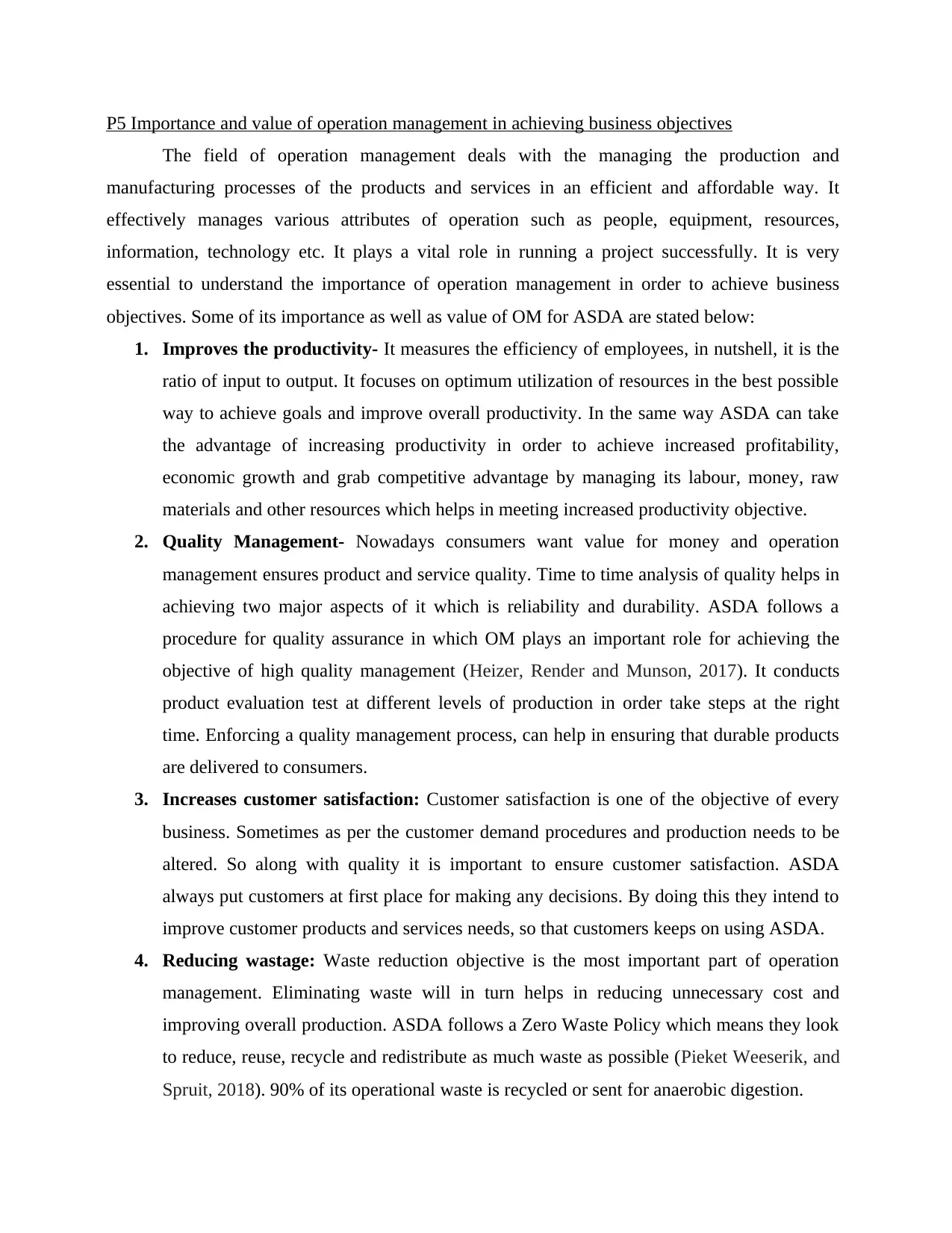
P5 Importance and value of operation management in achieving business objectives
The field of operation management deals with the managing the production and
manufacturing processes of the products and services in an efficient and affordable way. It
effectively manages various attributes of operation such as people, equipment, resources,
information, technology etc. It plays a vital role in running a project successfully. It is very
essential to understand the importance of operation management in order to achieve business
objectives. Some of its importance as well as value of OM for ASDA are stated below:
1. Improves the productivity- It measures the efficiency of employees, in nutshell, it is the
ratio of input to output. It focuses on optimum utilization of resources in the best possible
way to achieve goals and improve overall productivity. In the same way ASDA can take
the advantage of increasing productivity in order to achieve increased profitability,
economic growth and grab competitive advantage by managing its labour, money, raw
materials and other resources which helps in meeting increased productivity objective.
2. Quality Management- Nowadays consumers want value for money and operation
management ensures product and service quality. Time to time analysis of quality helps in
achieving two major aspects of it which is reliability and durability. ASDA follows a
procedure for quality assurance in which OM plays an important role for achieving the
objective of high quality management (Heizer, Render and Munson, 2017). It conducts
product evaluation test at different levels of production in order take steps at the right
time. Enforcing a quality management process, can help in ensuring that durable products
are delivered to consumers.
3. Increases customer satisfaction: Customer satisfaction is one of the objective of every
business. Sometimes as per the customer demand procedures and production needs to be
altered. So along with quality it is important to ensure customer satisfaction. ASDA
always put customers at first place for making any decisions. By doing this they intend to
improve customer products and services needs, so that customers keeps on using ASDA.
4. Reducing wastage: Waste reduction objective is the most important part of operation
management. Eliminating waste will in turn helps in reducing unnecessary cost and
improving overall production. ASDA follows a Zero Waste Policy which means they look
to reduce, reuse, recycle and redistribute as much waste as possible (Pieket Weeserik, and
Spruit, 2018). 90% of its operational waste is recycled or sent for anaerobic digestion.
The field of operation management deals with the managing the production and
manufacturing processes of the products and services in an efficient and affordable way. It
effectively manages various attributes of operation such as people, equipment, resources,
information, technology etc. It plays a vital role in running a project successfully. It is very
essential to understand the importance of operation management in order to achieve business
objectives. Some of its importance as well as value of OM for ASDA are stated below:
1. Improves the productivity- It measures the efficiency of employees, in nutshell, it is the
ratio of input to output. It focuses on optimum utilization of resources in the best possible
way to achieve goals and improve overall productivity. In the same way ASDA can take
the advantage of increasing productivity in order to achieve increased profitability,
economic growth and grab competitive advantage by managing its labour, money, raw
materials and other resources which helps in meeting increased productivity objective.
2. Quality Management- Nowadays consumers want value for money and operation
management ensures product and service quality. Time to time analysis of quality helps in
achieving two major aspects of it which is reliability and durability. ASDA follows a
procedure for quality assurance in which OM plays an important role for achieving the
objective of high quality management (Heizer, Render and Munson, 2017). It conducts
product evaluation test at different levels of production in order take steps at the right
time. Enforcing a quality management process, can help in ensuring that durable products
are delivered to consumers.
3. Increases customer satisfaction: Customer satisfaction is one of the objective of every
business. Sometimes as per the customer demand procedures and production needs to be
altered. So along with quality it is important to ensure customer satisfaction. ASDA
always put customers at first place for making any decisions. By doing this they intend to
improve customer products and services needs, so that customers keeps on using ASDA.
4. Reducing wastage: Waste reduction objective is the most important part of operation
management. Eliminating waste will in turn helps in reducing unnecessary cost and
improving overall production. ASDA follows a Zero Waste Policy which means they look
to reduce, reuse, recycle and redistribute as much waste as possible (Pieket Weeserik, and
Spruit, 2018). 90% of its operational waste is recycled or sent for anaerobic digestion.
Paraphrase This Document
Need a fresh take? Get an instant paraphrase of this document with our AI Paraphraser
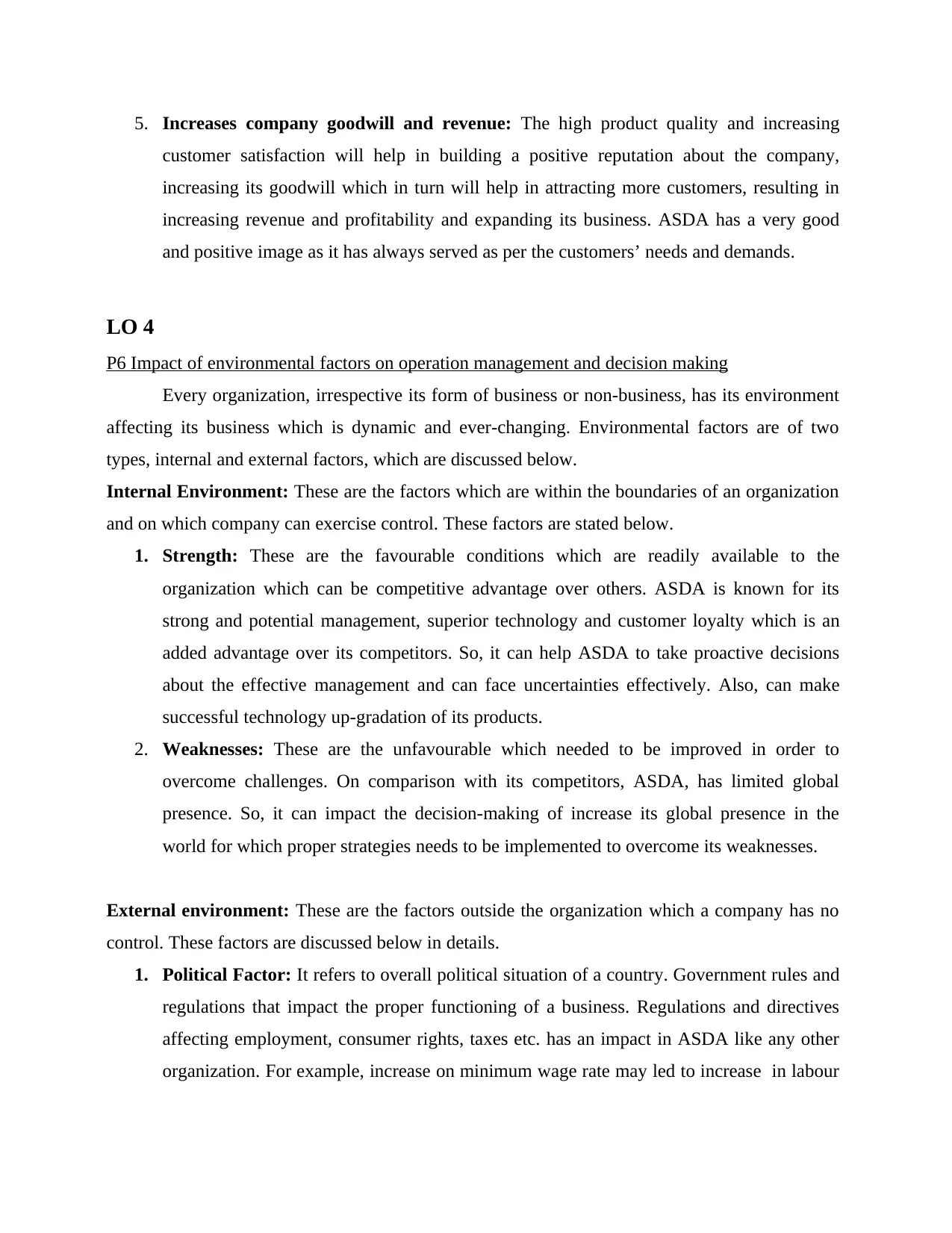
5. Increases company goodwill and revenue: The high product quality and increasing
customer satisfaction will help in building a positive reputation about the company,
increasing its goodwill which in turn will help in attracting more customers, resulting in
increasing revenue and profitability and expanding its business. ASDA has a very good
and positive image as it has always served as per the customers’ needs and demands.
LO 4
P6 Impact of environmental factors on operation management and decision making
Every organization, irrespective its form of business or non-business, has its environment
affecting its business which is dynamic and ever-changing. Environmental factors are of two
types, internal and external factors, which are discussed below.
Internal Environment: These are the factors which are within the boundaries of an organization
and on which company can exercise control. These factors are stated below.
1. Strength: These are the favourable conditions which are readily available to the
organization which can be competitive advantage over others. ASDA is known for its
strong and potential management, superior technology and customer loyalty which is an
added advantage over its competitors. So, it can help ASDA to take proactive decisions
about the effective management and can face uncertainties effectively. Also, can make
successful technology up-gradation of its products.
2. Weaknesses: These are the unfavourable which needed to be improved in order to
overcome challenges. On comparison with its competitors, ASDA, has limited global
presence. So, it can impact the decision-making of increase its global presence in the
world for which proper strategies needs to be implemented to overcome its weaknesses.
External environment: These are the factors outside the organization which a company has no
control. These factors are discussed below in details.
1. Political Factor: It refers to overall political situation of a country. Government rules and
regulations that impact the proper functioning of a business. Regulations and directives
affecting employment, consumer rights, taxes etc. has an impact in ASDA like any other
organization. For example, increase on minimum wage rate may led to increase in labour
customer satisfaction will help in building a positive reputation about the company,
increasing its goodwill which in turn will help in attracting more customers, resulting in
increasing revenue and profitability and expanding its business. ASDA has a very good
and positive image as it has always served as per the customers’ needs and demands.
LO 4
P6 Impact of environmental factors on operation management and decision making
Every organization, irrespective its form of business or non-business, has its environment
affecting its business which is dynamic and ever-changing. Environmental factors are of two
types, internal and external factors, which are discussed below.
Internal Environment: These are the factors which are within the boundaries of an organization
and on which company can exercise control. These factors are stated below.
1. Strength: These are the favourable conditions which are readily available to the
organization which can be competitive advantage over others. ASDA is known for its
strong and potential management, superior technology and customer loyalty which is an
added advantage over its competitors. So, it can help ASDA to take proactive decisions
about the effective management and can face uncertainties effectively. Also, can make
successful technology up-gradation of its products.
2. Weaknesses: These are the unfavourable which needed to be improved in order to
overcome challenges. On comparison with its competitors, ASDA, has limited global
presence. So, it can impact the decision-making of increase its global presence in the
world for which proper strategies needs to be implemented to overcome its weaknesses.
External environment: These are the factors outside the organization which a company has no
control. These factors are discussed below in details.
1. Political Factor: It refers to overall political situation of a country. Government rules and
regulations that impact the proper functioning of a business. Regulations and directives
affecting employment, consumer rights, taxes etc. has an impact in ASDA like any other
organization. For example, increase on minimum wage rate may led to increase in labour
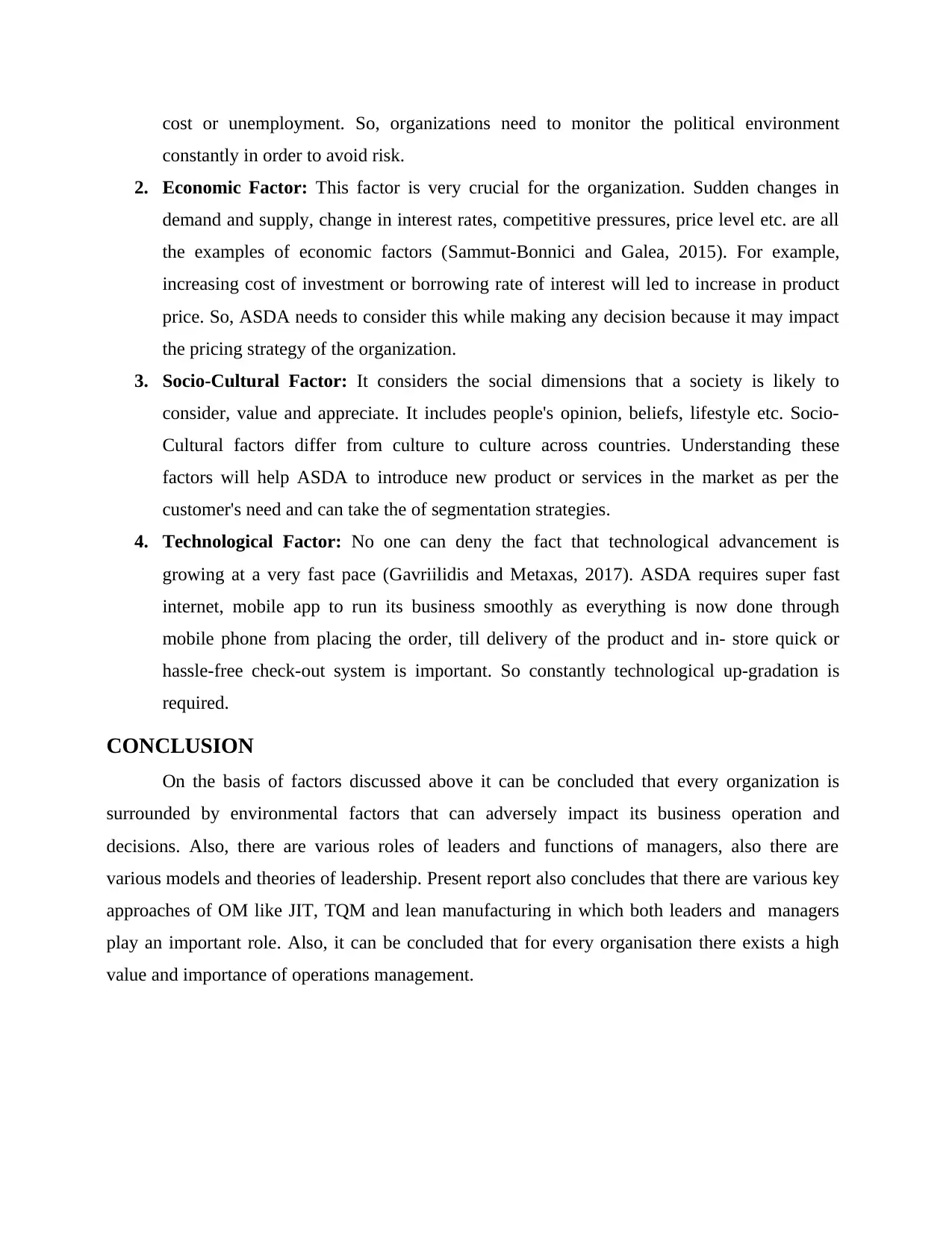
cost or unemployment. So, organizations need to monitor the political environment
constantly in order to avoid risk.
2. Economic Factor: This factor is very crucial for the organization. Sudden changes in
demand and supply, change in interest rates, competitive pressures, price level etc. are all
the examples of economic factors (Sammut‐Bonnici and Galea, 2015). For example,
increasing cost of investment or borrowing rate of interest will led to increase in product
price. So, ASDA needs to consider this while making any decision because it may impact
the pricing strategy of the organization.
3. Socio-Cultural Factor: It considers the social dimensions that a society is likely to
consider, value and appreciate. It includes people's opinion, beliefs, lifestyle etc. Socio-
Cultural factors differ from culture to culture across countries. Understanding these
factors will help ASDA to introduce new product or services in the market as per the
customer's need and can take the of segmentation strategies.
4. Technological Factor: No one can deny the fact that technological advancement is
growing at a very fast pace (Gavriilidis and Metaxas, 2017). ASDA requires super fast
internet, mobile app to run its business smoothly as everything is now done through
mobile phone from placing the order, till delivery of the product and in- store quick or
hassle-free check-out system is important. So constantly technological up-gradation is
required.
CONCLUSION
On the basis of factors discussed above it can be concluded that every organization is
surrounded by environmental factors that can adversely impact its business operation and
decisions. Also, there are various roles of leaders and functions of managers, also there are
various models and theories of leadership. Present report also concludes that there are various key
approaches of OM like JIT, TQM and lean manufacturing in which both leaders and managers
play an important role. Also, it can be concluded that for every organisation there exists a high
value and importance of operations management.
constantly in order to avoid risk.
2. Economic Factor: This factor is very crucial for the organization. Sudden changes in
demand and supply, change in interest rates, competitive pressures, price level etc. are all
the examples of economic factors (Sammut‐Bonnici and Galea, 2015). For example,
increasing cost of investment or borrowing rate of interest will led to increase in product
price. So, ASDA needs to consider this while making any decision because it may impact
the pricing strategy of the organization.
3. Socio-Cultural Factor: It considers the social dimensions that a society is likely to
consider, value and appreciate. It includes people's opinion, beliefs, lifestyle etc. Socio-
Cultural factors differ from culture to culture across countries. Understanding these
factors will help ASDA to introduce new product or services in the market as per the
customer's need and can take the of segmentation strategies.
4. Technological Factor: No one can deny the fact that technological advancement is
growing at a very fast pace (Gavriilidis and Metaxas, 2017). ASDA requires super fast
internet, mobile app to run its business smoothly as everything is now done through
mobile phone from placing the order, till delivery of the product and in- store quick or
hassle-free check-out system is important. So constantly technological up-gradation is
required.
CONCLUSION
On the basis of factors discussed above it can be concluded that every organization is
surrounded by environmental factors that can adversely impact its business operation and
decisions. Also, there are various roles of leaders and functions of managers, also there are
various models and theories of leadership. Present report also concludes that there are various key
approaches of OM like JIT, TQM and lean manufacturing in which both leaders and managers
play an important role. Also, it can be concluded that for every organisation there exists a high
value and importance of operations management.
⊘ This is a preview!⊘
Do you want full access?
Subscribe today to unlock all pages.

Trusted by 1+ million students worldwide
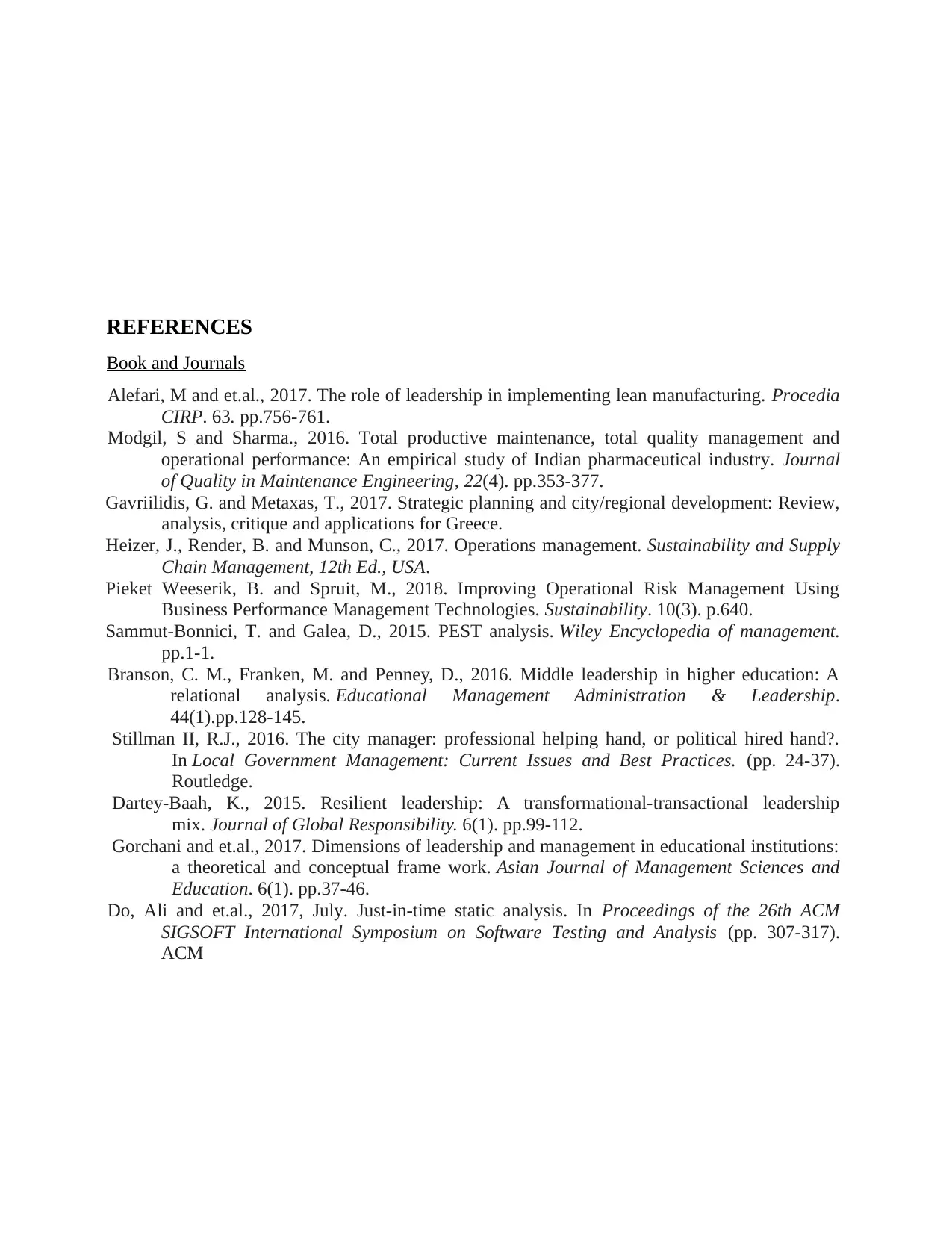
REFERENCES
Book and Journals
Alefari, M and et.al., 2017. The role of leadership in implementing lean manufacturing. Procedia
CIRP. 63. pp.756-761.
Modgil, S and Sharma., 2016. Total productive maintenance, total quality management and
operational performance: An empirical study of Indian pharmaceutical industry. Journal
of Quality in Maintenance Engineering, 22(4). pp.353-377.
Gavriilidis, G. and Metaxas, T., 2017. Strategic planning and city/regional development: Review,
analysis, critique and applications for Greece.
Heizer, J., Render, B. and Munson, C., 2017. Operations management. Sustainability and Supply
Chain Management, 12th Ed., USA.
Pieket Weeserik, B. and Spruit, M., 2018. Improving Operational Risk Management Using
Business Performance Management Technologies. Sustainability. 10(3). p.640.
Sammut‐Bonnici, T. and Galea, D., 2015. PEST analysis. Wiley Encyclopedia of management.
pp.1-1.
Branson, C. M., Franken, M. and Penney, D., 2016. Middle leadership in higher education: A
relational analysis. Educational Management Administration & Leadership.
44(1).pp.128-145.
Stillman II, R.J., 2016. The city manager: professional helping hand, or political hired hand?.
In Local Government Management: Current Issues and Best Practices. (pp. 24-37).
Routledge.
Dartey-Baah, K., 2015. Resilient leadership: A transformational-transactional leadership
mix. Journal of Global Responsibility. 6(1). pp.99-112.
Gorchani and et.al., 2017. Dimensions of leadership and management in educational institutions:
a theoretical and conceptual frame work. Asian Journal of Management Sciences and
Education. 6(1). pp.37-46.
Do, Ali and et.al., 2017, July. Just-in-time static analysis. In Proceedings of the 26th ACM
SIGSOFT International Symposium on Software Testing and Analysis (pp. 307-317).
ACM
Book and Journals
Alefari, M and et.al., 2017. The role of leadership in implementing lean manufacturing. Procedia
CIRP. 63. pp.756-761.
Modgil, S and Sharma., 2016. Total productive maintenance, total quality management and
operational performance: An empirical study of Indian pharmaceutical industry. Journal
of Quality in Maintenance Engineering, 22(4). pp.353-377.
Gavriilidis, G. and Metaxas, T., 2017. Strategic planning and city/regional development: Review,
analysis, critique and applications for Greece.
Heizer, J., Render, B. and Munson, C., 2017. Operations management. Sustainability and Supply
Chain Management, 12th Ed., USA.
Pieket Weeserik, B. and Spruit, M., 2018. Improving Operational Risk Management Using
Business Performance Management Technologies. Sustainability. 10(3). p.640.
Sammut‐Bonnici, T. and Galea, D., 2015. PEST analysis. Wiley Encyclopedia of management.
pp.1-1.
Branson, C. M., Franken, M. and Penney, D., 2016. Middle leadership in higher education: A
relational analysis. Educational Management Administration & Leadership.
44(1).pp.128-145.
Stillman II, R.J., 2016. The city manager: professional helping hand, or political hired hand?.
In Local Government Management: Current Issues and Best Practices. (pp. 24-37).
Routledge.
Dartey-Baah, K., 2015. Resilient leadership: A transformational-transactional leadership
mix. Journal of Global Responsibility. 6(1). pp.99-112.
Gorchani and et.al., 2017. Dimensions of leadership and management in educational institutions:
a theoretical and conceptual frame work. Asian Journal of Management Sciences and
Education. 6(1). pp.37-46.
Do, Ali and et.al., 2017, July. Just-in-time static analysis. In Proceedings of the 26th ACM
SIGSOFT International Symposium on Software Testing and Analysis (pp. 307-317).
ACM
Paraphrase This Document
Need a fresh take? Get an instant paraphrase of this document with our AI Paraphraser

1 out of 11
Related Documents
Your All-in-One AI-Powered Toolkit for Academic Success.
+13062052269
info@desklib.com
Available 24*7 on WhatsApp / Email
![[object Object]](/_next/static/media/star-bottom.7253800d.svg)
Unlock your academic potential
Copyright © 2020–2025 A2Z Services. All Rights Reserved. Developed and managed by ZUCOL.





